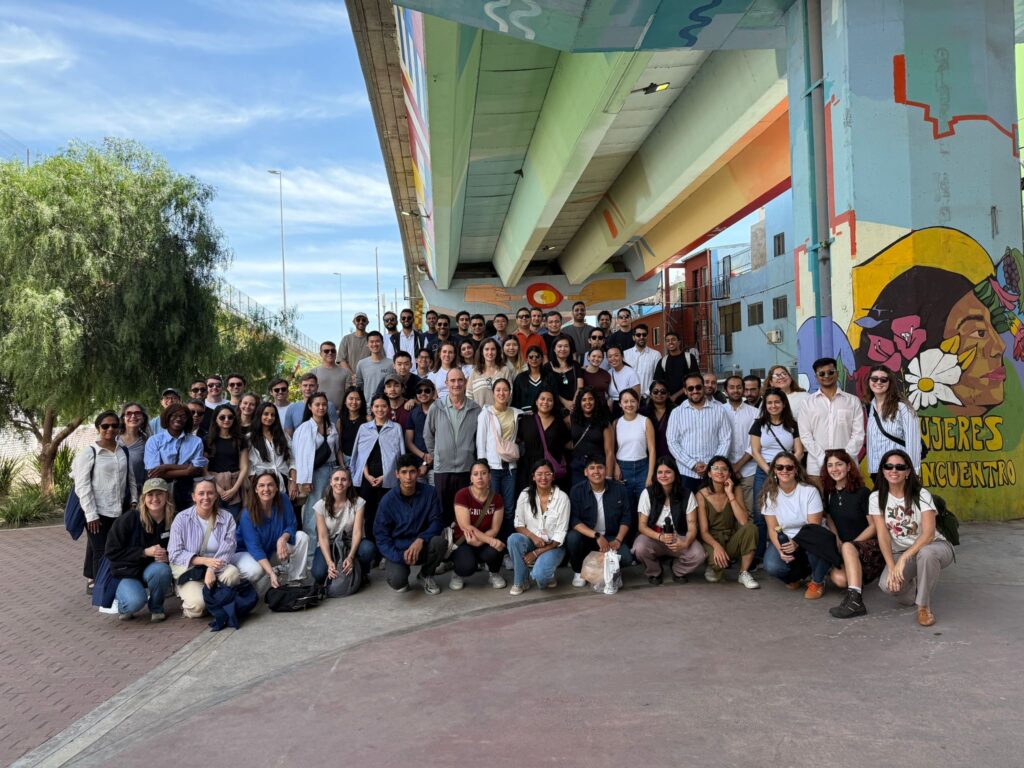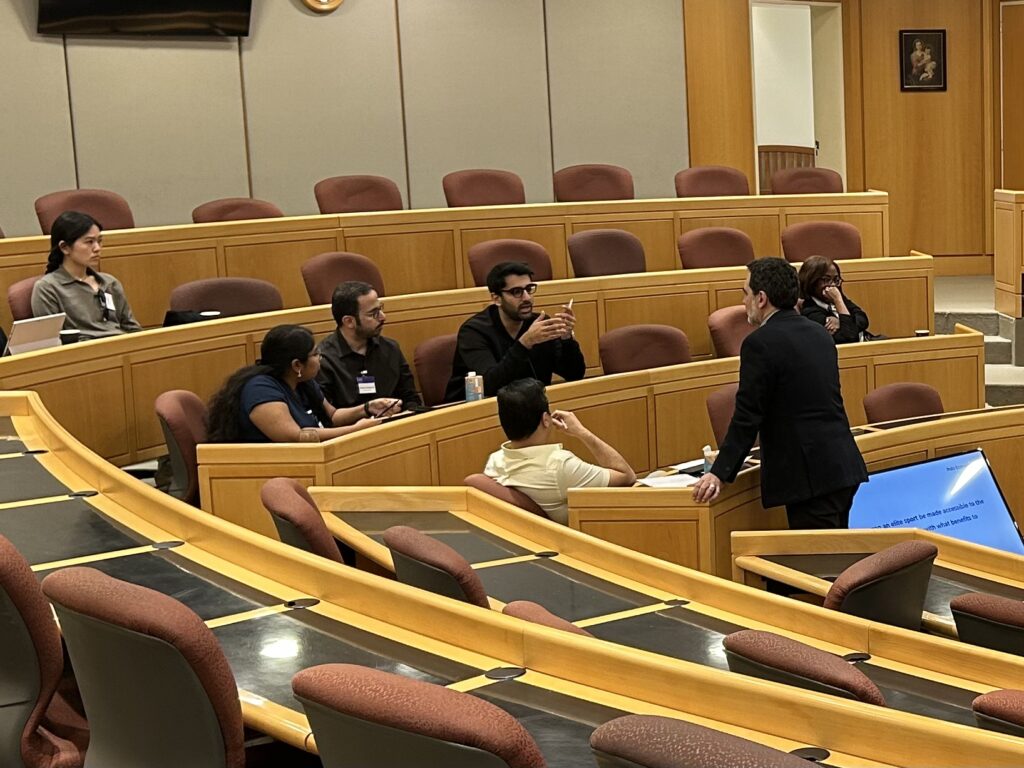By Ishaan Sharma, MBA2026
What is a Global Experience?

Imagine stepping off a plane, jet-lagged but buzzing with excitement, into a city that instantly makes you rethink everything you know about business. That’s the magic of the Global Experience (GE) at London Business School. It’s not your typical classroom adventure, GE takes students to destinations like Buenos Aires, Johannesburg, Paris, and Lima to explore how business thrives (and sometimes survives) across borders. Each trip is led by world-class faculty and packed with company visits, workshops, and late-night debates. You get to meet real entrepreneurs, roll up your sleeves with local partners, and tackle messy, live challenges. Our cohort was off to Buenos Aires, Argentina where we would spend one intense, unforgettable week exploring a question tailor-made for today’s uncertain world: how do you manage through crisis and volatility? Spoiler alert: Argentina knows a thing or two about that.

Our Theme: Managing Through Crisis and Volatility
If the word “volatility” makes your palms sweat, imagine running a business in a country where inflation runs at triple digits and uncertainty is the only constant. That’s life in Argentina. While many economies enjoyed slow-moving change over recent decades, Argentina’s annual inflation peaked at over 211% in 2023. In 2024 alone core inflation averaged around 145%, compared to Latin America’s regional average of about 74%. This kind of environment forces business leaders not just to react but to build business models that thrive while everything around them shakes. For our GE week, we immersed ourselves in exactly that: real-time lessons in resilience, agility and leadership under pressure. Our mission: learn how Argentine organisations don’t just survive the storm, but often convert it into opportunity.
Touchdown in Buenos Aires: Setting the Stage for Our Global Experience

The adventure began the moment we landed in Buenos Aires. Our GE team whisked us off on a whirlwind city tour showcasing the city’s many faces i.e. the colourful streets of La Boca, the elegance of Recoleta, and the sleek modernity of Puerto Madero. Every corner buzzed with life, contrast, and creativity. As we cruised past murals and tango dancers, we were briefed on what lay ahead: company visits, academic sessions, and leadership discussions, all set against the backdrop of an upcoming national election. It was clear this wouldn’t be a typical classroom experience “Buenos Aires itself was the classroom”. From café conversations to taxi rides, every moment offered a new lesson in adaptability. Our week would revolve around three core experiences : 1. Academic learning at IAE Business School, 2. Company visits, and 3. Guest speakers. Each offering a unique rhythm in the city’s dance with volatility :
1. Learning at IAE Business School

Our first stop was IAE Business School, where the real deep-diving began. Professor Gabriel Sánchez Zinny, former Minister of Education and current Chief of Staff to Buenos Aires’ mayor, set the tone by sharing firsthand insights into Argentina’s economic volatility and how policy decisions ripple through everyday business. Next up, Professor Francisco Díaz Hermelo unpacked the fascinating “Argentine Pendulum,” explaining how the country constantly swings between Peronism and neoliberalism: a political balancing act that shapes its markets. With elections just a week away, the conversation felt electric. We then turned theory into practice at a conference “How to Co-Create Value in Turbulent Environments”. Teaming up with IAE students, my group tackled how to attract venture capital investment in Argentina. Presenting our ideas to real VCs and government officials was exhilarating. A reminder that collaboration fuels creativity, even in chaos.
2. Company Visits: Lessons in Resilience

If volatility had a masterclass, Argentina’s businesses would be teaching it. Our first visit was to Vista Energy, a company that skyrocketed from zero to multi-million-dollar success in just seven years. Their mindset felt more Silicon Valley than South America (fast, data-driven, and fearless). It proved that agility beats size when the ground keeps shifting. Next, we visited Ferrosider, a third-generation, family-run steel company that could easily be the poster child for perseverance. Led by strong female founders and a CEO who’s been there for 47 years, they shared how they survived the 2001 Argentine crisis, when their workforce dropped from 2,000 to just 150. Their loyalty to their employees and community was inspiring. Together, Vista and Ferrosider taught us one thing: resilience isn’t built in boardrooms, it’s forged in the fires of uncertainty.
3. Guest Speakers and Insights

Just when we thought we’d seen it all, the guest speakers brought fresh energy to the mix. Anna Cohen, founder of the Cohen Group, told us how she built a financial services firm that thrived despite Argentina’s ever-changing economy. Her story was a perfect blend of grit, innovation, and optimism. Then came Horacio Reyser, Argentina’s former Secretary for International Economic Relations. With the calm confidence of someone who’s negotiated global trade deals, he shared his perspective on how Argentina can re-engage with the world economy. His advice stuck with me: “Don’t wait for stability but build systems that succeed despite instability.” That line became the unofficial motto of our trip. By the end of his talk, we realized that volatility isn’t an obstacle. It’s a playground for those bold enough to build anyway.
Connecting the Dots: Our Final Assessment
Our final challenge was to connect everything we’d learned. We were handed ten big questions covering everything from corruption and leadership styles to Argentina’s place in global business. But this wasn’t your average exam, it was a reflection marathon. We had to weave insights from professors, company visits, and guest speakers into coherent lessons on how to lead in uncertainty. My biggest realization? Argentina’s unpredictability forces its leaders to become experts in adaptability. The companies we met didn’t wait for better conditions but they built better capabilities. The week taught us to look at volatility not as a barrier, but as a breeding ground for creativity, courage, and collaboration. And while my coffee consumption tripled, so did my appreciation for resilience as a competitive advantage.
The Fun Part

Of course, no GE is complete without a healthy dose of culture and chaos. On our first evening, we traded business cards for conversation at a reception hosted by the British High Commission, mingling with diplomats and LBS alumni. It was a surreal reminder of how far the LBS network stretches and how small the world can feel when you’re part of it. Another highlight was our visit to Barrio Mugica, one of Buenos Aires’ oldest informal settlements. Once defined by poverty, it’s now transforming thanks to local initiatives and the Ministry of Education. Walking through its streets and speaking to residents were deeply moving. It reminded us that business and community are inseparable. Between tango nights, street art, and way too many empanadas, Buenos Aires gave us both lessons and memories we’ll never forget.
Final Reflections…

Looking back, the GE was more than a study trip, it was a crash course in thriving amid uncertainty. Argentina taught us that volatility isn’t the enemy; complacency is. The leaders we met showed that innovation, trust, and adaptability can outlast even the toughest crises. The experience reminded me that leadership isn’t about steering through calm waters but it’s about dancing through the storm. Much like a tango in Buenos Aires, success here is about rhythm, balance, and learning to improvise when the music changes. This was one of the best experiences of my MBA journey: a whirlwind of ideas, culture, and laughter that left me inspired, humbled, and ready for whatever comes next.
